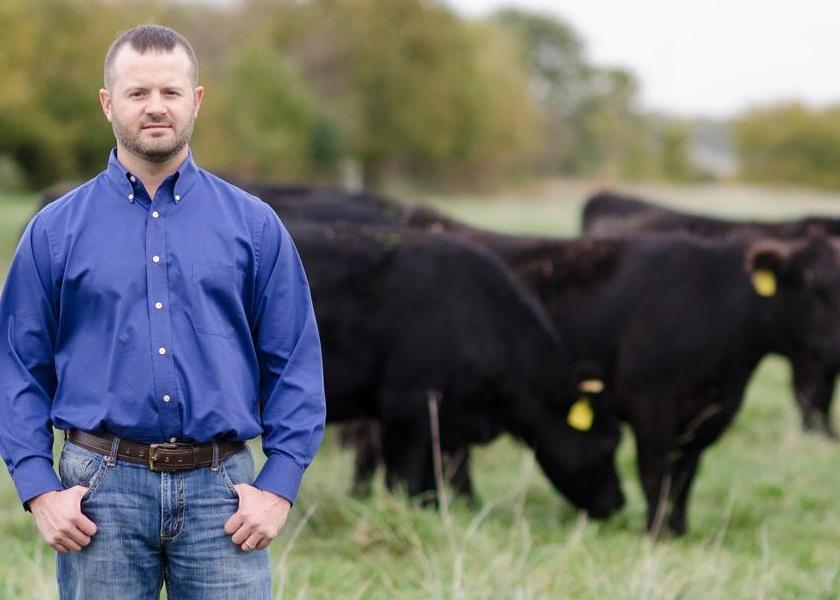Midwestern Beef Production Works Just as Well Off Pasture

Beef producers in the upper Midwest know grazing land is in short supply. With more acres being developed or converted to cropland, producers who want to expand their cow-calf operations are looking for alternatives to traditional pasture management.
New research from University of Illinois animal scientists and I-BELIEF students shows cow-calf pairs can be managed in drylots throughout the summer grazing period with few negative consequences.
When we extended the drylot phase throughout the summer, we were able to get excellent performance on our drylot cows. They maintained body weight and body condition and had good reproductive rates. Everything was excellent in that regard. Calves on the drylot had increased performance throughout the pre-weaning phase, as well,” says Dan Shike, associate professor in the Department of Animal Sciences at U of I and lead researcher on the study.
The team compared Angus × Simmental cow-calf pairs on pasture and in drylots – in this case, concrete lots and open-front sheds with bedding – between May and August, repeated over two years. Broadly, they looked at growth performance, lactation, locomotion, and calf behavior at weaning and during the feedlot receiving period.
“Producers who want to explore drylotting have a lot of questions, so we tried to tackle as many of the big-picture answers as we could,” Shike says.
In the drylot, cows were limit-fed a standard TMR maintenance diet, but calves had free access to the same diet in an adjacent creep pen. Pairs on pasture grazed available forage, with calves nursing and eating a processed creep feed three weeks prior to weaning.
The research team expected cows and calves to do as well or better in the drylot, and that’s just what they found.
“The cows in the drylot performed exactly as we intended because we had more control over their environment and were able to formulate a ration to meet their nutritional needs. The cows in the pasture are really at the mercy of the weather,” Shike says. “Consequently, the cows on pasture had lower body weight and body condition score compared to cows in the drylot.”
Calves did better in the drylot than pasture, again because of the controlled diet and environment. When it was time for weaning and shipment to the feedlot, pasture-raised calves were significantly smaller than their drylot-raised counterparts.
“We anticipated the pasture-raised calves would have compensatory gain, and they did. They had higher rates of gain and tended to be more efficient in that receiving phase,” Shike says. “But, even after 42 days, they hadn’t caught up because they started so far behind the drylot calves in weight.”
Pasture-raised calves were brought into the drylot for weaning, where they had nose-to-nose access to their mothers in adjacent pens. Calves raised in the drylot stayed in place, but were separated from their mothers by a fence. Drylot calves seemed somewhat less stressed at this phase, according to behavioral indicators including vocalization, eating, walking, and lying down.
After six days of weaning, calves were transported 170 miles from the Orr Agricultural Research and Demonstration Center in Baylis to the U of I campus farms to begin the feedlot phase. Surprisingly, pasture-raised calves showed fewer signs of stress during feedlot receiving than their drylot-raised counterparts.
“We were thinking if they're in a drylot, they're already used to an intensive system. Maybe that will help them transition to another intensive system like the feedlot. But it didn't give them an advantage. That was probably one of our more surprising findings,” says Josh McCann, assistant professor in animal sciences and co-author on the study.
“We think calves on pasture may have adapted faster to the feedlot because they had already gone through one transition – from the pasture to pen at weaning – and because being on pasture gives them more physical separation from their moms. We could imagine they were more mentally prepared to be separated when shipped to the feedlot. For the drylot pairs, it's like when your kids stay home with you all day, sending them off to school becomes a little more stressful at first.”
The researchers say producers should consider a few potential risks associated with drylotting. In the study, they found a higher incidence of foot and leg issues, including lameness and problems with locomotion.
Shike says, “The dairy industry certainly experienced more issues with feet and legs as they intensified and moved cows into confinement. The beef industry will have to pay attention to this issue as well, but there are things we can do in terms of how we manage bedding and drainage. Even though we had to treat some cows, it ultimately didn't impact body weight, body condition, or reproduction. There was some labor and expense associated with treating them, though.”
Although the team didn’t conduct an economic analysis, McCann notes the cost of treating locomotion issues isn’t the only expense to consider.
“An intensive system requires more labor and, of course, there’s the cost of feed,” he says. “There wasn’t much of a downside to the drylot system for animal performance, but producers will want to look at the economic tradeoffs for their individual operations.”
The study, “Effects of housing beef cow-calf pairs on drylot or pasture in the Midwest on production parameters and calf behavior through feedlot receiving,” is published in the Journal of Animal Science [DOI: 10.1093/jas/skab357]. The research was funded by the Iowa Beef Council Industry. The USDA-supported Illinois Beef Experiential Learning and Industry Exposure Fellowship (I-BELIEF) funded two student authors, Keifer Sexton and Lucas Hofer.







